I’m feeling old…old enough to remember covering model airplanes with tissue paper. Shrinking the tissue needed only a fine mist of water, for which an enterprising kid liberated a hairspray bottle. When tight and dry it was painted with fuel-proof dope. Monokote plastic covering film came along in the late ’60s, much to the relief of my mother, as “dope” had taken on a whole new meaning in the Age of Aquarius.
A few decades later, covering my first full-size airplane was, in some ways, a blast from the past. The fabric glued into place with sharp smelling stuff, just like that long-ago tissue, but this time there were no little bottles and camel hair brushes. This was the big-boy stuff…special coatings, special solvents, and a requirement to master a classic Binks No. 7 spray gun. The job only took a few months, and I only gave myself one minor case of isocyanate poisoning. It was grand.
Until recently, the application of liquid coatings was an integral part of all covering systems. Now, like the model airplane covering revolution of the ’60s, builders have a choice. The product, from Europe, is called Oratex. Let’s take a look.
No Dope, No Paint
Oratex is based on a woven polyester fabric, but unlike other aircraft fabric systems the weave filler, UV protection, and color coats are added at the factory. There is no overspray, odor, fire, or chemical safety issue. A builder may cover aircraft panels almost anywhere without risk, including an enclosed basement space or at the kitchen table. Even the adhesive is water-borne.
The system is a product of Lanitz-Prena Factory GmbH, located in the former East German city of Leipzig. Company founder Siegfried Lanitz has produced an extensive line of model airplane film coverings since 1985, including one with a polyester fabric backing. In 2001, a university design team selected that covering for an experimental microlight glider. It worked so well that Lanitz decided to develop covering materials for general aviation.
Today Lanitz-Prena manufactures two fabrics for full size aircraft, Oratex 600 and Oratex 6000. The numerical labels refer to the maximum allowable weight of the aircraft in kilograms, or if you prefer, 1323 or 13,228 pounds. Lanitz has already obtained Europe-wide EASA approval for a few certified aircraft. Several more approvals are in process, with a range from Piper J-3 to Antonov AN-2. In the USA, the fabrics are currently non-certified, Experimental only.
Beyond the Brochure
So what is it like to cover with Oratex, and what does it look like when finished? To answer these questions and more, I contacted the U.S. distributor, Lars Gleitsmann of Better Aircraft Fabrics, and proposed a field test. If Gleitsmann would supply materials, I would assemble three builders, cover airplane parts, and report our experience.
The builders were selected for their different backgrounds. The first, Bill Griffin, is an “old school” guy. Griffin knows how to get great results from his favorite conventional system, and he tends to stick with what he knows. The second, Bert Sparrow, is a novice builder, currently working on his first full-size airplane. He came to the test with limited fabric experience beyond model aircraft shrink films. I would be the third builder, with moderate covering experience, and an interest in exploring new methods and materials. To make it more realistic, I would first learn the system by reading the instructions and calling Gleitsmann as necessary for guidance, as any customer might do. Then I would work with the other two, much like an EAA Technical Counselor, to speed them along with personal instruction.
Griffin brought along an old Kolb Firestar elevator from his attic, and Sparrow supplied the rudder and elevator from his Aerodrome Fokker D-7. All are aluminum-tube structures assembled with blind rivets. We used Oratex 600, appropriate for this class of airplane.
The Basic Process
The first step is critical; the parts must be carefully cleaned. Oratex adhesive contains no solvents, thus it will not dissolve or disperse traces of grease, skin oil, or other surface contaminants that could compromise bond strength. Bonding is further improved if the surface is scuffed with a mild abrasive for tooth. The best prep for an aluminum tube structure is probably a thorough scrub with a water/detergent/acid solution, using a new red Scotch-Brite pad. When dry, the framework can be sprayed with a quality 2-part epoxy primer, or the builder may proceed directly to covering over bare aluminum.
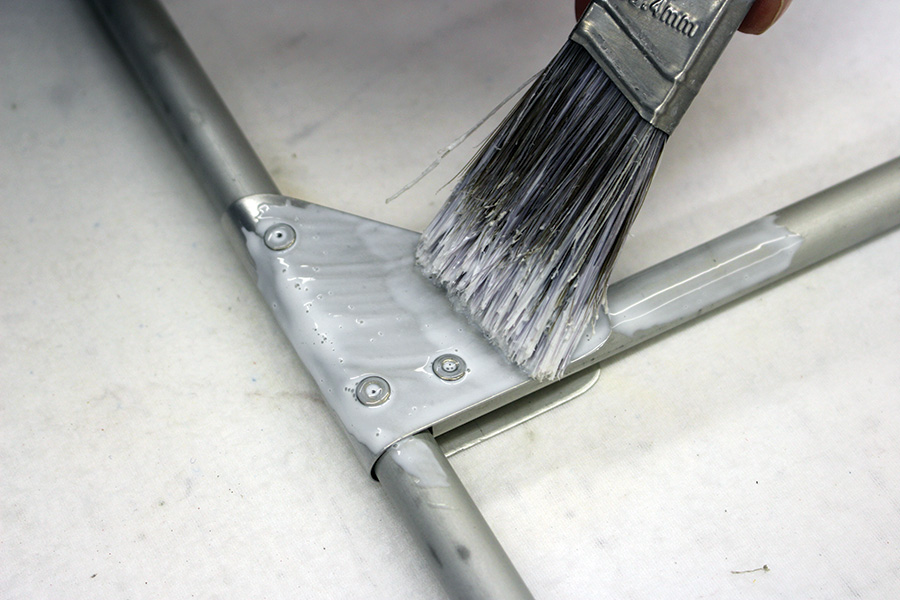
Fig. 1: After a thorough cleaning, scuff the parts to be covered with a mild abrasive, then apply Oratex adhesive with a brush.
The next step is to cover sharp edges and protrusions with a layer of Oratex. Brush adhesive on the area to be covered (Fig. 1), and on the backside of the fabric (Fig. 2). All Oratex bonds are the same in this regard; adhesive is always applied to both surfaces. Allow as much time as necessary for the water to completely evaporate from the adhesive. When dry, it will turn from milky white to a hazy clear, and feel firm to the touch. There is no time window; if desired, adhesive may be applied weeks in advance.

Fig. 2: In addition to the parts being covered, Oratex adhesive must also be applied to the backside of the fabric.
Cut a patch from the adhesive-coated fabric. It doesn’t need to be more than a quarter-inch or so larger than the feature to be covered. Iron it into place with a small hot iron (Fig. 3). As a rule, the adhesive must be brought up to 158 F and held there for 10 seconds, melting the glue, allowing it to flow, and beginning a cross-linking cure. The glue will adhere immediately, and in a warm shop (75 F) it will reach full strength in 24 hours.

Fig. 3: Cut a patch of adhesive-coated fabric about a quarter-inch larger than the object to be covered and iron it into place.
The actual iron setting needed to get the glue to 158 F will vary depending on the heat sink properties of the underlying material. With aluminum structure (the worst-case heat sink), we found an iron setting of 300 to 350 F worked well. There is no concern about burning or melting the fabric. The maximum application temperature is 392 F, and Oratex doesn’t actually melt until 482 F.
Lay the structure on the plain side of a fabric panel. Draw around the perimeter with a #2 pencil, then outline ribs or other structure that will also be glued to the fabric. Cut the panel to rough shape, leaving plenty of excess fabric (6 to 8 inches) outside the perimeter at curved sections. The excess offers something to grab and pull, as the fabric needs to be stretched around curved tubes. Brush a layer of adhesive just inside the perimeter line, several inches outside, and along the rib lines. The goal is simple; you want adhesive on the fabric everywhere it will contact the structure.
Brush adhesive over all the new anti-chafe patches, and any structure previously missed. When both structure and fabric are dry, start bonding along a straight section, usually the tube with the hinges. A complete wrap around the tube is desired. The fabric can be pre-trimmed to match the tube size by using a little math—add tube diameter x pi x 0.8 to the perimeter line (Fig. 4). However, it usually works better to use the excess to pull around the tube, heating and stretching the fabric, then marking and trimming the excess.

Fig. 4: Fabric can be pre-trimmed to match the tube size by using a little math—add tube diameter x pi x 0.8 to the perimeter line.
Go slow, apply pressure to the iron, and be sure to heat every square inch. Straight sections are easy. Curved sections may require cutting small darts so the fabric will wrap without bunching. Keep going until the entire perimeter is neatly wrapped and ironed (Fig. 5).

Fig. 5: This is how a completed section looks; it’s important to go slow, apply pressure to the iron, and heat every square inch.
Prepare the opposite fabric panel as before; position the part on a new fabric section, mark a perimeter line, cut oversize, and apply adhesive to the plain side everywhere bonding is expected.
The new panel will overlap the first all around the perimeter. The minimum overlap rules are simple. Wing fabric should overlap 4 inches at the leading edge and 2 inches at the trailing edge. Tail surface fabric (and similar structures with small tube diameters) should overlap at least 2 inches at the leading edge and 1 inch at the trailing edge. It is necessary to apply adhesive within the overlap area, on the outside of the previously applied fabric. To keep it neat, determine where the overlap will end, and run masking tape to define the edge. Wipe the bond area with alcohol, then brush on the adhesive and pull the tape while it is still wet. When the adhesive has dried, position the fabric and tack it with the iron along the straight sections. Trim to the desired overlap and iron down those sections. Now start pulling the fabric around the curved sections with one hand while ironing it with the other (Fig. 6).
Stretching while heating is a fundamental technique when working with Oratex. With enough effort and heat the fabric can be wrapped around compound shapes without puckering (Fig. 7). When fully wrapped, trim the excess to the desired overlap dimension, iron down the remainder, and proceed to finishing tape.

Fig. 7: With enough effort and heat, the fabric can be wrapped around compound shapes without puckering.
There is no Oratex bias tape; application to a curved perimeter is entirely a matter of applying enough heat and tension. We found it was a job best done with two people (Fig. 8). I was typically pulling 20 pounds or more on the fabric while Griffin kept the panel in optimum position. The large iron was set on 350 F.
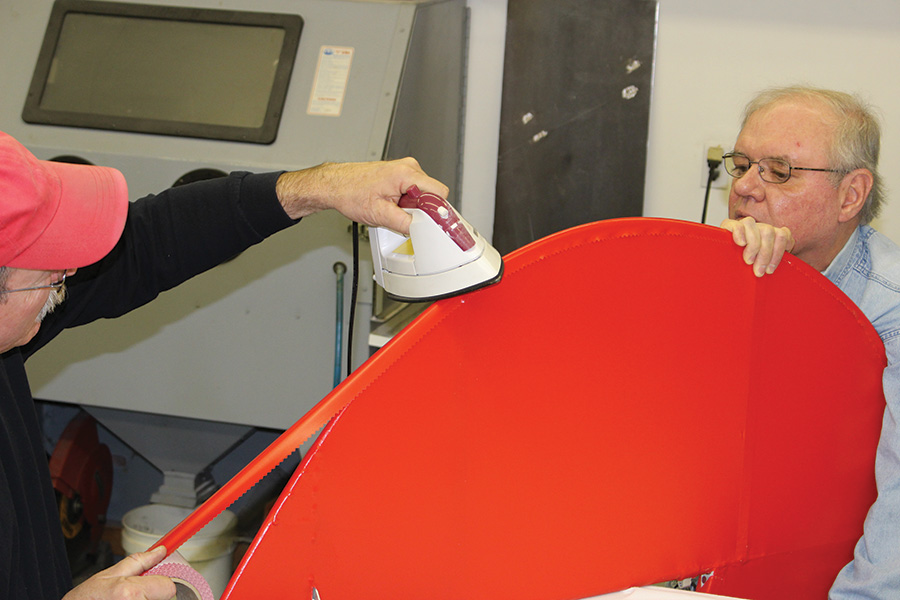
Fig. 8: Applying fabric to a curved perimeter is best done with two people. Bill Griffin holds the panel in place while the author pulls and irons the fabric.
The center of the tape, where heat is applied, will stretch enough to allow the non-heated, and now shorter, edges to lie down. From there it only takes a few moments with the iron to finish the job (Fig. 9).
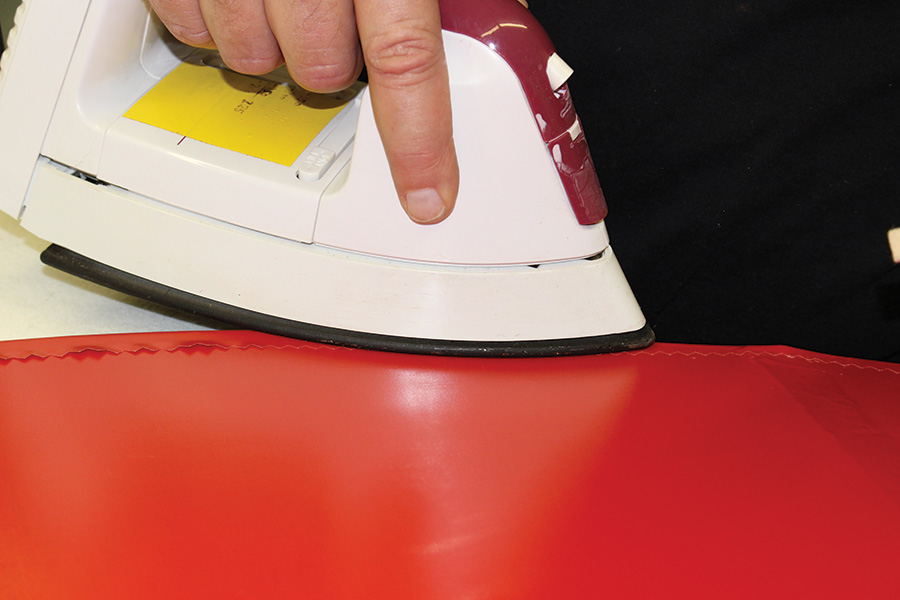
Fig. 9: When heat is applied to the center of the tape, it stretches enough to allow the non-heated, and now shorter, edges to lie down. They can be smoothed with an iron.
Oratex tape is self-adhesive; the heat-activated glue is applied to the backside of the tape at the factory. You will apply some additional brushed-on adhesive over rib stitching and other surface protrusions prior to taping, as doing so improves overall adhesion and helps prevent trapped air.
Observations
The Oratex process is, as promised, very clean. There is no smell or airborne vapor. The only liquid is the adhesive, which is no more threatening than milk, and the application brush rinses out with plain water. There is also no special need for ventilation, so the room may be sealed, then heated or cooled without loss.
At first we felt like the process was very slow, and it is, if fabric application time is the only criteria. The truth didn’t really sink in until we found ourselves examining a finished panel…and realizing it really was finished. With a conventional system, the covering process would be followed by a round or two of spraying and sanding fillers and UV blockers, then spraying color.
There is a learning curve, as with any process. We all got faster with more experience. I had no difficulty pioneering our group using just the written instructions, and calling Gleitsmann only once for guidance on taping curves. Griffin found most of the techniques familiar and was working happily within minutes. Sparrow, our covering novice, turned out work every bit as good as the rest after just a show and tell. That alone says a lot about the product concept. Fifteen minutes wouldn’t have been enough to teach him how to get similar results with a spray gun.
Everyone found pre-covering sharp edges and protrusions with heat-bonded Oratex scrap to be slow and tedious. It took hours to do something done in minutes with conventional anti-chafe tape. Although we would be tempted to test with self-adhesive cloth tape, the prescribed method does result in complete adhesion from the structure outward, and is probably superior.
We all noted that errors are harder to fix compared to a conventional system. With either, spot heat will allow limited adjustment. The solvent-based covering systems will also release with a drop of MEK, plus the iron will mold small folds or puckers into a smooth, unified mass. Attempting to mold Oratex in a similar manner tends to damage the color coat and make the error more obvious.
Along the same lines, the irons must be clean and free of sharp edges, and release paper should be used between the iron and the fabric when working near rivets and protrusions. It is easy to damage the color coat by shaving or scuffing the top off a raised spot, exposing the underlying white fabric.
Waiting for the waterborne adhesive to dry created gaps of 20 to 30 minutes in the workflow, despite maintaining 70 F and low humidity in a climate-controlled shop. A cold or humid shop may be even slower. If you have the space, the best approach would be to keep two or three panels in process at the same time. That way you could work on the next panel after brushing adhesive on the previous.
Drying time aside, Oratex hot-melt adhesive is very, very impressive. I set up simple bonding tests using inch-wide strips of both Oratex 6000 and certified medium-weight polyester. The samples were glued (using their respective proprietary adhesives) to a properly cleaned and scuffed 2-inch diameter bare aluminum tube. The tube was then mounted in a bench fixture as a freely rotating drum.
To compare peel strength, the strips were simply pulled with an electronic scale; the free drum guaranteed the pull vector was always perpendicular to the surface. The Oratex samples exhibited between five and eight times more peel strength than the popular certified adhesive.
To examine shear strength, each strip was carefully peeled until exactly one square inch of bond area remained attached to the drum. The free end of one strip was then anchored to the bench, with the drum positioned so the adhesive patch was just beyond the tangent. The drum was rotated with a lever, tensioning the sample. When pulled with considerable force, the Oratex 6000 strip always ruptured before the one square inch adhesive bond…and remember, 6000 is the heavyweight material. A builder working with clean, scuffed surfaces and adequate heat need not worry about bond strength.
In a related observation, we found that removing bonded and cured fabric from structure required care, as you could easily pull hard enough to bend tubing while trying to peel fabric.
While covering his Kolb elevator (a difficult case due to the infamous “Kolb Bumps”), Griffin and I got the impression that Oratex 600 doesn’t shrink as much as uncertified light dacron polyester. So, another simple test: we shrank identical length strip samples side by side, at the same time, on an insulated surface, using the Swiss Toko iron at 320 F.
We found that Oratex 600 shrank 3.7% in both warp (lengthwise) and woof (across the roll), as compared to 8.9% warp and 7.8% woof for standard lightweight polyester. That is a large practical difference when covering. We also compared Oratex 6000 fabric and certified medium weight polyester. In warp, the 6000 shrank 5.2% vs 8.3% for the certified medium fabric. The woof axis was a practical draw at 6.8% vs 6.3%.
The low shrinkage is not an insurmountable problem, but it does require a change in covering technique. In a situation where standard fabrics might easily pull tight, the Oratex must be heated and stretched before bonding. It works fine, but the stretching can be hard on arthritic hands, and often works best with two people.
The finished surface is not the dipped-in-glass wet look of polyurethane topcoats, but rather more of a nice soft gloss. The fabric weave is apparent, and the pinked edges on the tapes stand in stark relief. Every square inch of the “paint” finish is perfect, as it comes that way off the roll. All the sample colors were vivid and rich.
The Verdict?
We liked it. We even have a future project in mind. Griffin put it best: “Working with this stuff is not harder, easier, better, or worse…it’s just different!”
Tradition has its place. The nice folks who fancy Staggerwings and Tiger Moths expect fabric and dope, and might consider anything else to be gauche. Likewise, I wouldn’t expect to see Oratex on the ailerons of a warbird restoration, where authenticity is everything. For those owners, conventional covering is the sensible choice…and their favorite restoration shop has a paint booth.
Not so for Regular Joe. His facility is half an attached garage, and blowing overspray out the window on his neighbor’s new car just isn’t going to work. Joe needs a practical way to cover with minimal overhead and risk. For Joe, Oratex is a serious step ahead. It’s light, fast, harmless, and it looks good.
Joe, welcome to the future.
For more information, contact Better Aircraft Fabric www.betteraircraftfabric.com. Lars Gleitsmann at 907-229-6792 [email protected] or Paul Mills at 907-440-7033 [email protected].



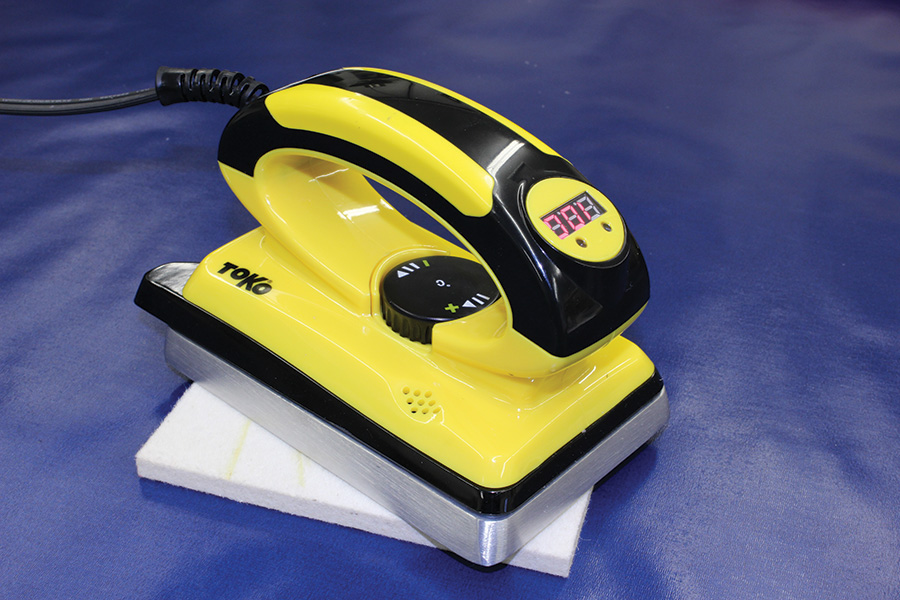





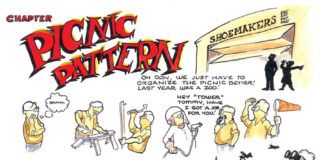
Dan,
Thank you for the wonderful article and all the hard work put in in testing Oratex. Very useful information for me as I am currently considering it for covering my microlight glider. I know the article is six years old, but relevant none the less as there are very few independent testings out there. Hope you are still flying the blue skies!
Best Regards,
Raymond J Hahn
Tyler Hill, PA
Como e onde posso comprar o material oratex